Abstract
Analytical techniques were developed combining the Surnames of Y-STR DNA matches, the 1911 Census of Ireland, and geographical place names to pinpoint the ‘Genetic Homeland’ of five (5) of eight (8) individuals used as test cases. Four (4) of the individuals were natives of Ireland and one (1) was a native of Scotland. The Genetic Homeland concept is based on the area where founding ancestors first adopted surnames and lived for hundreds or thousands of years. Although the surnames adopted may have been diverse and many or all descendants with a particular surname may have moved away from those areas, the geographical place names and other descendants from the same patriarch often remain in those geographies today.
Introduction
There are approximately 1,800 Clans associated with Ireland, many of these Clans have unique surnames and have arisen from a single founding ancestor. Even when Clans share a surname they are typically associated with separate geographical areas and in the absence of migratory evidence may similarly have arisen from unrelated founding ancestors. Medieval Gaelic Ireland was an intensely hierarchical society where the honor of establishing one’s own Clan was earned. In this manner new Clans and hence new surnames appeared in distinct geographical locations surrounded by territories occupied by Clans from whom they often evolved and with whom they share common ancestry. Given Ireland’s lack of an industrial revolution and its obsession with land and land ownership, it was hypothesized that early 20th Century census data can still be used to pinpoint the precise medieval geographical location of each Clan.
A son typically inherits two things from his father, his surname and his Y chromosome. The surname has changed considerably since his ancestor first adopted it, in Ireland it has been anglicized from its original Gaelic to English, often losing its Mac, or O’ in the process. Even its spelling in English has evolved over the centuries from, for example, O’Bouey, to Boe, and Bowe to its current form Bowes. The surname has often changed so much so that its original meaning in Gaelic can only be guessed at. However, in the estimated thousand years since an ancestor took his surname, the Y chromosome inherited from him remains virtually identical. This is assuming of course that he has inherited his Y chromosome, given that on average only 50% of individuals sharing a unique surname will have inherited the original Y chromosome of the founding ancestor. Where the Surname does not match the Y chromosome it is the result of what scientists refer to as a ‘non-paternal event,’ which encompasses such events as adoption, infidelity, and illegitimacy, often resulting in the maternal transmission of a surname.7 Only analysis of the Y chromosome will reveal whether maternal transmission has occurred.
Genetic genealogy for descendants of Irish ancestors is made easy for several reasons. Ireland was the first Country in Europe to adopt inherited paternal surnames. 478 These surnames were a genealogical record in themselves, denoted by Mac’ or O’ meaning son of, or grandson of respectively. For a people on the edge of Europe, for whom there was no where else to go, land meant everything. Land was held by the Clan, which means family in English, and was bitterly fought over and defended for centuries. Hence each Clan occupied its territory for hundreds if not thousands of years leaving their mark on the placenames of their territory. Even with the arrival of Vikings, Normans, and later 16th and 17th Century Scots and English, the Native Irish remained and toiled the land merely switching a Native Irish Chieftain for a Norman Knight or English lord.2 Using commercial Y chromosome DNA testing, the Family Tree DNA database, the 1911 census of Ireland, Microsoft Excel, customized mapping software for surname distribution mapping, Ordnance Survey Ireland maps, and Google Earth it is possible to explore the relationships between a test subjects surname, and the surnames of his genetic matches to pinpoint the Genetic Homeland of an individual, and find evidence of their ancestors presence in the placenames and DNA of the areas current inhabitants.
Methodology
In total eight (8) subjects were recruited for commercial 37-marker Y chromosome testing performed by Family Tree DNA.12 The surnames of the test subjects were: Bowes, Egan, Foy, Donohoe, Bell, Villalard, Fogarty, and Berkery. With the exception of Villalard each of the test subjects were born in Ireland and have recent Irish ancestry. None of the test subjects have expressed any knowledge as to the origins of their distant ancestors. These surnames are a representation of modern Irish surnames encompassing the most common ethnicities; Egan, Foy, Donohoe, Berkery, and Fogarty are surnames associated with Native Irish/Gaelic society, and Bowes and Bell are of putative British origin. The test subject Villalard was of Anglo-French origin born in Jersey, Channel Islands and is most likely representative of Norman ancestry.
The surnames of each test subject’s genetic matches were individually examined, and classified according to: 1. the degree, or strength of the genetic match (e.g. 37/37 matching markers > 36/37 > 35/37 > 34/37 > 25/25 > 24/25), and 2. Whether or not the surname, or spelling variants of the surname ‘reoccur’ as genetic matches, if so the surname is included in preliminary analysis. In this manner singularly occurring surname matches, which are more likely to be associated with non-paternal events and unrelated to the founding ancestors surname, are identified and excluded from the preliminary analysis to identify the Genetic Homeland.
For each of the eight test subjects the number of people with his surname, and the surname of his closest reoccurring genetic matches were entered onto a spreadsheet according to the county of residence in Ireland in 1911. The data was used to create bar charts, and plotted using a customized 32 county map of Ireland produced by MapInXL to identify the county or counties where the Genetic Homeland is located. Once an area was identified as a ‘Genetic Homeland’ it was examined using Ordnance Survey Ireland 1:50000 Discovery Series maps for placenames associated with the surnames of the test subject and his closest genetic matches as evidence for historical association and occupation of that area. The geographical medieval location of Irish Clans and associated placenames were positioned and displayed using Google Earth.
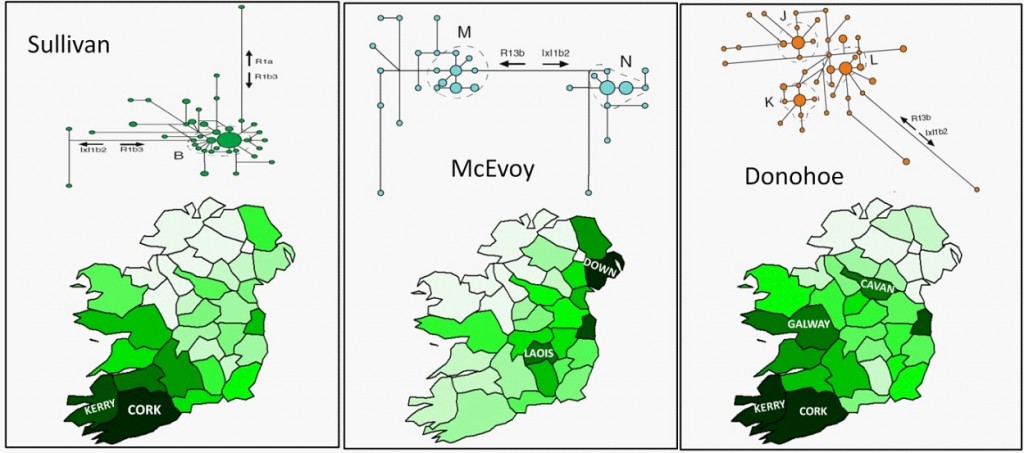
Fig. 1: Phylogenetic and Geographical Distribution for Sullivan, McEvoy, and Donohoe Surnames
MJ Networks and surname distribution mapping show a clear association between the number of founding ancestors and the number of geographical areas where the Surname is concentrated. Previous research has shown using Median-Joining (MJ) networks that Sullivan, McEvoy, and Donohoe were associated with 1(B), 2 (M and N), and 3 (J, K, and L) founding ancestors respectively. Similarly Sullivan is concentrated in a single geographical location on the borderland between counties Cork and Kerry, while McEvoy is associated with 2 separate locations in counties Laois, and Down. Donohoe is associated with at least 3 geographically distant locations in counties Kerry, Galway, and Cavan. 7 Distribution maps are taken from the Irish Origenes database (www.irishorigenes.com).
Results
The “One Clan One Man” Hypothesis
In a previous study it was suggested that Irish surnames associated with more than one founding ancestor have arisen independently in different geographical locations or possibly as a result of multiple biologically prominent males within a community.9 If a surname has indeed arisen from multiple biologically prominent males within a community then it is more likely to be associated with a single geographical location, whereas if the founding ancestors are unrelated and have arisen independently then there is a greater likelihood that the surname will be concentrated in multiple geographically distinct areas. This can be answered by examining the geographical distribution of surnames where the number of founding ancestors is known. Previous research by McEvoy and Bradley (2006) showed that the surname Sullivan is associated with a single founding ancestor. Sullivan is also associated with a single geographical location and is concentrated in the borderland between counties Cork and Kerry (Figure 1). Similarly, McEvoy (McAvoy) with two founding ancestors is found in two distinct geographical locations, in counties Laois and Down (Figure 1). Donohoe, meanwhile, which research has demonstrated has three founding ancestors is concentrated in at least three geographically distant locations: in counties Kerry, Galway and Cavan (Figure 1).
The Surnames of Ones Genetic Matches are Snapshot of Ones Ancient Neighbors
In light of the clear evidence to support the ‘One man one Clan hypothesis,’ and if one considers that Clans evolved from one another, then it is logical to assume that new Clans and new surnames will have emerged surrounded by, or close to, Clans with whom the share ancestry. Given the expansion of the Family Tree DNA database, this will potentially be reflected in the surnames of each test subject’s genetic matches. Of the eight test subjects, only one individual (Fogarty) had no genetic matches, the remaining seven individuals had on average 513 matches, the surnames of each test subjects closest reoccurring genetic matches are listed in Figure 2.
Fig. 2: Table 1 Surname Matches for Eight Test Subjects on Y-STR 37-Markers
Surnames of the closest reoccurring genetic matches of the eight test subjects. All test subjects were of the R1b1a2 Haplotype. Surnames are shown at the point at which they first occur as a genetic match, numbers in brackets indicates the number of people with a particular surname that are genetic matches for the individual tested. The surname matches of four test subjects showed clear Native Irish/Gaelic ancestry (highlighted in green), while three showed Norman and British ancestry (highlighted in blue). Only one test Subject, Fogarty failed to match anyone on the database. Note: To rule out surnames associated with non-paternal events only surnames that occur more than once in a test Subjects results are listed. [1] The test subject Foy was adopted and his biological fathers surname was Whelehan. [2] Multiple related individuals called ‘Springer’ have been tested and hence this surname, although a result of a non-paternal event appears more than once as a Bowes match. [3] Downie is a variant of the surname Muldowney.
Clan Bowe’s in County Laois
The closest genetic matches for Bowes were to individuals with the surnames Carroll and Dooley (Figure 2). Both of these surnames occur more than once within the 900 genetic matches for this test subject, this is the criteria for minimizing surnames associated with non-paternal events. However the reoccurring matches with the surname Springer, which has no historical association with Ireland, was intriguing. Subsequent investigation revealed that multiple distant members of the Springer family have had the Y chromosome test, and that their most distant relative could be placed in Barbados in the 16th Century, the likelihood is that this is a non-paternal event and so this surname was not included in subsequent analysis.
When the Bowe, Carroll and Dooley surnames are plotted according to their distribution throughout the 32 Counties of Ireland there is a clear association with county Laois, one of Irelands smallest and least populated counties (Figure 4, panel A). When these surnames are placed on a map of county Laois in the area where they are concentrated, their proximity to one another is clearly visible (Figure 4, panel B). In addition each of these Clans has left clear evidence of their association in the placenames found within county Laois, including Bowe’s, and Dooley’s crossroads and Ballycarroll (Figure 4, panel C).
Fig. 3: Table 2 Surname Matches for Bowes Test Subjects on Y-STR 67-Markers
Although only one Bowe(s) matched the test subject at the 37 marker level (Table 1), subsequent upgrading to 67 markers demonstrated shared ancestry with the 3 other members of the Ely Carroll group of ‘Irish’ Bowes.
Fig. 4: Clans Bowes, Carroll, and Dooley
The Clan Bowes Genetic Homeland is found on the borderland between counties Laois and Kilkenny. By plotting the surnames Bowe, Carroll and Dooley, corrected for relative population size and expressed as a percentage there is a clear association with county Laois, panel A. When all 3 Clans are placed in the area where the surname is concentrated their relative proximity to each other is clearly visible, panel B. Evidence of the association of these surnames with this area is also found in the surrounding placenames, Clan Bowe in Bowe’s crossroads, Toberboe and Aghaboe, which translate as ‘Boe’s well’ and ‘Boe’s field’ respectively (Flanagan, 2002, p.12, 153). Clan Dooley’s presence is reflected in Dooley’s crossroads and Killadooley (Dooley’s Church) and Clan Carroll with Ballycarroll (Carroll’s town) (Flanagan, 2002, p.20, 49). County Clan maps (panel B) are taken from the Irish Origenes, Native Irish county Clan maps database (www.irishorigenes.com, 2011).
Clan Egan in County Roscommon
The closest genetic matches for ‘Egan’ were individuals with the surnames Keegan and Egan respectively (Figure 2). The surname Egan has arisen from the Anglicization of the Gaelic surname ‘MacAohagain’6 , while Keegan appears to have has arisen as a spelling variation of Egan, a fact reflected in its distribution pattern in a 32 county map of Ireland compared with Egan (Figure 5). Using surname distribution mapping the Egan surname appears to be centered upon the banks of the Shannon on the Roscommon/Offaly/Galway borderland and is indicative of a single Clan with a single founding ancestor. However when the surnames of the genetic matches are plotted on a bar chart (Figure 6, Panel A) there are two prominent peaks focused on counties Roscommon and Offaly and their neighboring counties, this is the first indications that there are two related Clans situated relatively close to one another.
Fig. 5: Surname distribution mapping of the surnames Egan and Keegan
The surname Egan shows a typical surname distribution pattern that is focalized on the borderland between counties Offaly, Roscommon, and Galway, and is indicative of a single clan with a single founding ancestor. In comparison the distribution of the surname Keegan is erratic and found concentrated in counties that border the principal areas of Egan settlement which is typical of surname variants. Distribution maps are taken from the Irish Origenes database (www.irishorigenes.com).
Land is typically passed from father to son, and by plotting the number of Farmers with the surnames of the genetic matches it was observed that there were 2 centers of Egan habitation on opposite banks of the river Shannon, the most numerous Egan Clan is found in southwest Offaly by the banks of the river Shannon while the other is found in Northwest Roscommon in territory that the borders both Mayo and Galway (Figure 6, panel B).
Both Egan Clans may be distantly related and potentially arose as a result of migration, however the Clan to which the test subject shares most recent ancestry, may be determined by examining the surname distribution of his other genetic matches. The surname Dunne is associated mainly with the Offaly/Laois borderland but there is also a minor Dunne Clan found on the Galway/Roscommon borderland, where Clans Tighe and Higgins are also found (Figure 6, panel B). The localization of Clan Egan, Dunne, Tighe and Higgins to Northwest Roscommon is a strong indication that this is the test Subject’s ‘Genetic Homeland.’ Evidence for their presence is found in the placenames found in this area and include Killegan, Lisnalegan, and Knockalegan, meaning Egan’s church, fort and hill respectively, although legan can often refer to a ‘standing stone’. 3 There is clear evidence of Clan Dunne settlement in ‘Dunn’s village, and Clan Tighe (Teige, the Gaelic for the personal name Timothy) reflected in the placenames Derreenteige, and Coolteige meaning Timothy’s little oak wood, and little hill respectively (Figure 6 panel C).13
Fig. 6: Clan Egan of County Roscommon
When the surnames of the test subject’s genetic matches were plotted according to their distribution throughout the 32 counties of Ireland and corrected for relative population size and expressed as a percentage, there was a clear association with Counties Roscommon and Offaly, panel A. There are two areas associated with Clan Egan indicating that there are two related Clans, found in North Roscommon near the Galway and Mayo border, and in county Offaly by the banks of the river Shannon, panel B. Clan Egan in Roscommon is most likely the site of the test subjects ‘Genetic Homeland’ given the close proximity of Clan’s Tighe, Higgin’s and a smaller Clan Dunne. Panel C shows an area in panel B, bordered by a broken blue line that shows evidence in the placenames of Clan Egan’s association with this area, including Killegan, Knockalegan, and Lisnaegan. Clan Tighe’s presence is reflected in Derreenteige and Coolteige, and Clan Dunne in Dunn’s village. County Clan maps (panel B) are taken from the Irish Origenes, Native Irish county Clan maps database (www.irishorigenes.com, 2011). 13
Clan Donohoe in County Kerry
There were no genetic matches for this test subject at the 37 marker level (Figure 2). At the 25 marker level there was the first of many Donohoe matches, and an O’Keeffe, both associated with Native Irish ancestry, and Gibbons, derived from Fitzgibbons which is a Norman surname and more likely to be associated with a non-paternal event. Other Gaelic surnames that frequently occurred as genetic matches at the 25 marker level include Donovan, Moriarty, Daly, O’Brien, McCarthy and Sullivan. These surnames are, if the theory is correct, a snapshot of his ancestor’s medieval neighbors. Given that there at least three distinct ‘Donohoe Clans’ in three geographically distant locations (Figure 1), each geographical location was examined to identify which Donohoe Clan is situated in close proximity to these genetically matching surnames/Clans. None of these genetically matching Clans are found in close proximity to Clan Donohoe of county Cavan (Figure 7, panel A) or Clan Donohoe of Galway (data not shown). Remarkably Clan Donohoe in county Kerry is literally surrounded by both surnames that occurred frequently as genetic matches like O’Keeffe, Sullivan, McCarthy, Donovan, Murphy, Regan and Clifford, but also by surnames that appear as rare or single matches like Moriarty, Flynn, Brick, and Dennehy (Figure 7 panel B). Some of these surnames like Sullivan (Figure 1), Donovan, Moriarty, Brick, Dennehy, and O’Keeffe are associated with a single founding ancestor and hence with a single geographical location situated in the Southwest of Ireland.
Fig. 7: Clan Donohoe of County Kerry
Clan Donohoe of county Cavan is not surrounded by any of the Clans that are genetically related to the test subject, and is not therefore his ancestral Clan, panel A. In comparison Clan Donohoe in county Kerry is surrounded by surnames (shown in yellow) with whom he shares common ancestry, panel B. Lough Leane (magnified from red border in panel B) is at the heart of Clan Donohoe territory and is busy with references in the placenames to Clan Donohoe (in yellow) and their genetic cousins (red, white, and green). County Clan maps (panel A and B) are taken from the Irish Origenes, Native Irish county Clan maps database (www.irishorigenes.com, 2011).
The county Kerry Clan Donohoe is concentrated just east of Killarney town and close to Lough Leane, where numerous references to the Donohoe’s and their genetic cousins can be found (Figure 7 panel C). The most impressive landmark is Ross Castle which does not bear the Donohoe surname but was built by this Clan in the 15th Century. Surrounding Ross castle are places like O’Donohoe’s prison, library, table, horse, spyglass and pigeon house. There are also placenames associated with the test subject’s genetic matches including Mahony’s point, McCarthy’s money well, O’Sullivan’s cascade and punch bowl.
The test subjects ‘Genetic Homeland’ is in Killarney in county Kerry, however probably one of the most important finding was that some of the surnames that occur singularly as genetic matches like Flynn and Brick can also be pointers to the Genetic Homeland. It is important to note that Flynn and Brick may be genetic relatives or even more intriguingly non-paternal events, either way they can still assist in pinpointing the Genetic Homeland of a test subject. It is logical to consider that in the 1,000 years since surnames came into use, non-paternal events are most likely to occur with your neighbors, be it with neighboring Gaelic Clans like Flynn and Brick, or with Norman families like Fitzgibbon and Hayes.
Foy; a Non-Paternal Event and a ‘Whelehan’ in Disguise
The final test subject with Native Irish ancestry called Foy is an example of a non-paternal event as the test subject was adopted, but was aware that his biological fathers surname was ‘Whelehan.’ His closest match in 33 of 37 markers was to another Whelehan (Figure 2). Whelehan is a distinct Clan unrelated to the much larger Clan Whelan/Phelan found further south in county Kilkenny. The surname Whelehan is found concentrated in the south of county Westmeath, near the county Offaly borderland where the Clan’s ancient territory would have been located. There were no reoccurring surnames at the 25 marker level that can place this test subject founding ancestor in Westmeath. The matches with surnames like Gallagher and McGee mark his more distant ancestor as part of the Niall of the Nine Hostages group which originates much earlier in the Northeast of Ireland.
9 However, as observed with the Donohoe test subject, there may be clues in the singularly occurring genetic matches with Native Irish surnames. These may reflect either low frequency Clans that are rare in the Family Tree DNA database or represent non-paternal events with neighboring medieval Clans or Norman families. The Irish surnames that occur at the 24 of 25 marker level are McCormack, Fagan and Downie (a variant of Muldowney) and when these, and Whelehan are plotted for their distribution throughout the 32 Counties of Ireland, 3 of these surnames (Whelehan, McCormack and Fagan) are associated with Westmeath (Figure 8, panel A). Further analysis of the test subjects genetic matches reveal a number of surnames that are associated with the territory surrounding Clan Whelehan (Figure 8, panel B).
Geographical evidence of Clan Whelehan’s association with this area can be found in two nearby placenames; including Derrywheelan (Whelehan’s oak wood) and Meelaghans crossroads, Meelaghan in this instance may refer to an early Anglicization of ‘Faoileachain,’ from which Whelehan is derived (Figure 8, panel B).6
Fig. 8: Clan Whelahan on the borderland of Counties Westmeath and Offaly
The test subject Foy was adopted and his biological fathers surname was Whelehan. The surnames of his singularly occurring genetic matches place his Genetic Homeland in county Westmeath, panel A. Clan Whelehan on the Westmeath/Offaly borderland is surrounded by Clans (in yellow) that occur as singular surname matches for the test subject, panel B. There are also 2 possible placenames (in red), Derryweelan, and Meelaghans crossroads that show possible evidence of Clan Whelehan’s association with this area.
The Normans; Berkery, Bell, and Villalard
The surname Berkery is described as a putative Native Irish surname by Maclysaght (2007, p. 17). However given the high number of matches to the Norman surname Butler this seems doubtful (Figure 2). The Norman Butler’s have a long association with the province of Munster, the first Baron Butler, and the first Chief Butler of Ireland built the Abbey of Owney near the village of Murroe in Limerick (Roche, 1995, p. 211). Surname distribution mapping shows that both Berkery and Butler are associated with counties Tipperary and Limerick (data not shown). In the absence of other Berkery’s on the Family Tree DNA database, this suggests a shared ancestor in counties Tipperary or Limerick. The Berkery surname may ultimately be of Norman origin and a possible branch of the Butler family.
The test subject Bell matched numerous other Bell’s, but also McCormack, Brown and Irvine in 36 of 37 markers (Figure 2). Other close matches include the surnames Graham, Nelson and Armstrong. This test subject’s ancestry lies in Scotland where there are two Clans Bell. The best known Clan Bell is associated with Dumfries and Galloway in the Scottish lowlands near the English border, while the lesser known Clan Bell is a branch of the MacMillan’s and is found in Argyle in the Highlands and Islands of western Scotland. The surnames Bell, Armstrong, Graham, and Nelson are associated with the Scottish/English borderland. Similarly there is a Clan ‘Broun’ (Brown) and a small Clan McCormack associated with Dumfries and Galloway. This places the test subjects Genetic Homeland in Dumfriesshire in the lowlands of Scotland, although his earlier ancestry may lead to Normandy as ‘Bell’ is supposedly derived from the surname Fitzbell.13
The test subject Villalard has no paternal link to Ireland and can trace his grandfather to Northern France at the beginning of the 20th Century. The DNA analysis did not reveal any reoccurring surname matches, probably representing the lack of test subjects with genetic origins in France on the Family Tree DNA database. Interestingly a number of Native Irish surnames occurred as single surname matches including; Brogan, Scully, Murphy, McGee/McKee, Whalen, and Byrne. These Irish surname matches are representative of non-paternal events arising after the Norman conquest of Ireland in 1169AD.
Using DNA to Confirm the Genetic Homeland of Clan Bowes
Once a Genetic Homeland has been identified it can be easily confirmed by a simple Y chromosome DNA test of people with a particular surname who currently live in that location. The Bowes surname is more commonly associated with county Durham in England, where there is an actual village called Bowes. In Ireland this surname has evolved separately and gradually as part of the Anglicization of a presumably similar sounding Irish surname. The Bowes surname DNA group has expanded considerably since 2004 when it was formed by Martha Bowes, and includes both Bowes of British and Irish origin. The individual Bowes tested in this study is part of a distinct group of four ‘Irish’ Bowe(s) who share genetic ancestry (Figure 3) and are part of the larger ‘Ely Carroll’ grouping of related Clans.14 Three of the members of this group, including this studies test subject, were tested over the last number of years and have no current association with counties Laois or Kilkenny. The final member of this group lives in county Kilkenny and is aware that his family has been associated with this area for hundreds of years. His results link this small group to the Clan Bowes ‘Genetic Homeland’ in the Laois/Kilkenny borderland. Other Bowes from counties Laois and Kilkenny are being recruited to establish a clear link between Clan Bowes and the Clans medieval territory on the Laois/Kilkenny border.
Discussion
Using only the Surnames of their genetic matches it has been possible to pinpoint the ‘Genetic Homeland’ of five (5) individuals, four with Native Irish ancestry and one of Scottish origin. This finding is quite remarkable given the varying degrees of genetic matches that occurred for each individual. However, unlike a manufactured human paper trail, the DNA cannot lie, and the pinpointed ‘Genetic Homeland’ can be verified by Y chromosome DNA testing of people with the test subjects surname in the identified area. In the case of the Bowes test subject this was achieved, and although only one individual was tested, he was a match to the other Irish Bowes and helps pinpoint the Genetic Homeland of Clan Bowes to the Laois/Kilkenny borderland. Although it is still a mystery as to how test subject Bell’s ancestor arrived in Ireland (either as a mercenary Scot known as Gallowglass or as a 16th and 17th Century Planter), his genetic matches place his surnames medieval founding ancestor in Dumfries and Galloway on the Scottish/English border. This analytical process may therefore be more broadly applicable and may potentially be employed in pinpointing the Genetic Homeland of people with Scottish, English, Welsh, and possibly wider European ancestry.
The investigative paper trail and the Y chromosome DNA tests are not mutually exclusive and should be seen as complimentary research tools for today’s Genealogist. The paper trail typically begins at the present day and can be followed, in most instances for 100 or 200 years. Meanwhile the DNA can essentially pinpoint the location where ones ancestor first took his surname, lived for hundreds and possibly thousands of years, leaving his mark on the areas current inhabitants and placenames and even historical records. In essence the Y chromosome DNA results provides today’s Genealogists with an endpoint, or starting point depending on one’s point of view, but in effect an area where they know that the paper trail will lead to.
In the case of the Irish Clan Bowes, a ‘Genetic Homeland’ was pinpointed to an area centered upon modern day Abbeyleix in county Laois. This is an area that can subsequently be examined for historical records that can place the Bowes ancestors in this location. One such document refers to O’buoey in Aghmacart in Laois in the 14th Century.11 This could be the earliest known reference to Clan Bowes in county Laois and further examination may yield more information that will shed light on the history of this Clan. The challenge therefore for today’s 21st Century Genealogist is to piece together the story of ones ancestors journey from his Genetic Heartland to the present day. Whether this will be possible given the often fragmentary historical records only time will tell.
Ordnance Survey
Acknowledgements
I would like to thank Martha Bowes, and Mrs Jeane Robinson for their helpful discussions, assistance, and suggestions. This paper is dedicated to the memory of John Bowes and Christopher Vilalard.References
- Burnell T (2006) The Anglicized words of Irish Placenames. Nonsuch Publishing, Ireland.
http://www.amazon.com/Anglicized-Words-Irish-Places/dp/1845885538 - Duffy S, Doherty G, Gillespie R, Kelly J, Lennon C, Smith B (2000) Atlas of Irish History (second edition). Gill and MacMillan, Ireland.
http://www.amazon.com/Atlas-Irish-History-Sean-Duffy/dp/0717153991 - Flanagan D, Flanagan L (2002) Irish Place Names. Gill and MacMillan, Ireland.
http://www.amazon.com/Irish-Place-Names-Deirdre-Flanagan/dp/071712066X/ - Hill, Emmeline W., Jobling, Mark A., Bradley, Daniel G.. Y-chromosome variation and Irish origins. Nature. 2000;404(6776):351-352. DOI:10.1038/35006158.
http://www.nature.com/nature/journal/v404/n6776/full/404351a0.html - Jobling, Mark A. In the name of the father: surnames and genetics. Trends in Genetics. 2001;17(6):353-357. DOI:10.1016/S0168-9525(01)02284-3.
http://dx.doi.org/10.1016/S0168-9525(01)02284-3 - MacLysaght E (2007) The Surnames of Ireland. Irish Academic Press, Ireland.
http://www.amazon.com/Surnames-Ireland-Edward-MacLysaght/dp/0716523663/ - McEvoy B, Bradley DG. Y-chromosomes and the extent of patrilineal ancestry in Irish surnames. Hum Genet. 2006 Mar;119(1-2):212-9. PubMed PMID:16408222.
http://www.ncbi.nlm.nih.gov/pubmed/16408222 - McEvoy B, Brady C, Moore LT, Bradley DG. The scale and nature of Viking settlement in Ireland from Y-chromosome admixture analysis. Eur J Hum Genet. 2006 Dec;14(12):1288-94. PubMed PMID:16957681.
http://www.ncbi.nlm.nih.gov/pubmed/16957681 - Moore LT, McEvoy B, Cape E, Simms K, Bradley DG. A Y-chromosome signature of hegemony in Gaelic Ireland. Am J Hum Genet. 2006 Feb;78(2):334-8. PubMed PMID:16358217.
http://www.ncbi.nlm.nih.gov/pubmed/16358217 - Roche R (1995) The Norman Invasion of Ireland. Anvil Books, Ireland.
http://www.amazon.com/Norman-Invasion-Ireland-Richard-Roche/dp/0947962816/ - 1466 Calendar of Papal Registers cited on the Bowes One Name Study
http://www.bowesonenamestudy.com/findings_2/distribution_and_frequency/ireland-2/1466-calendar-of-papal-regi.html - Family Tree DNA and FTDNA are names for Gene By Gene, Ltd, a commercial provider of genealogical DNA testing in Houston, Texas.
http://www.familytreedna.com - Clan Bell International, William Bell President
http://www.clanbell.org - Bowes DNA Surname Project, Martha Bowes
http://www.familytreedna.com/public/bowes/default.aspx?section=ycolorized

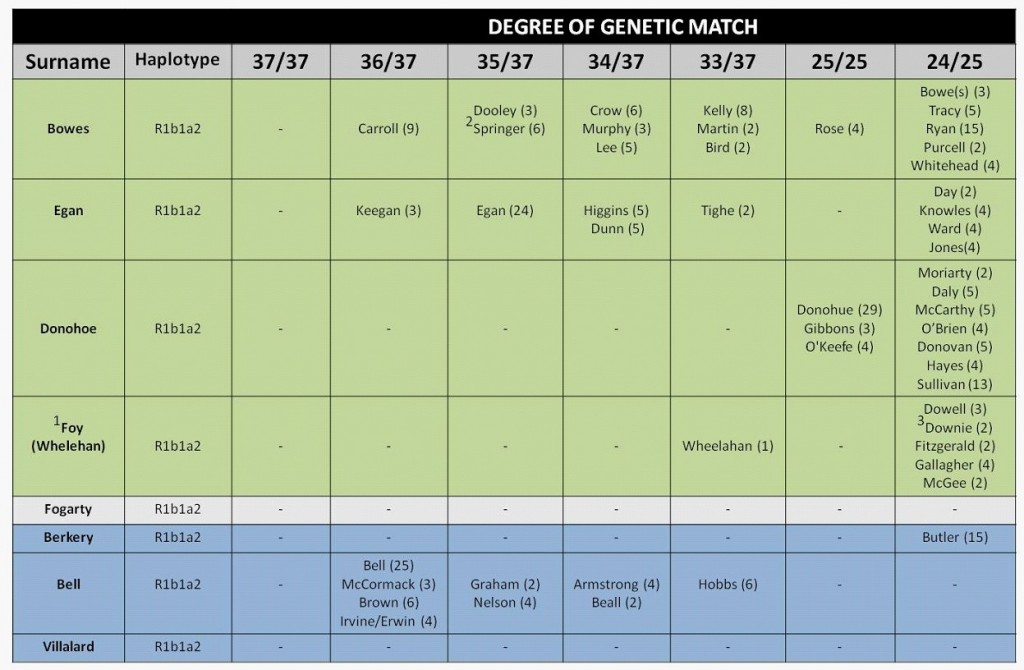
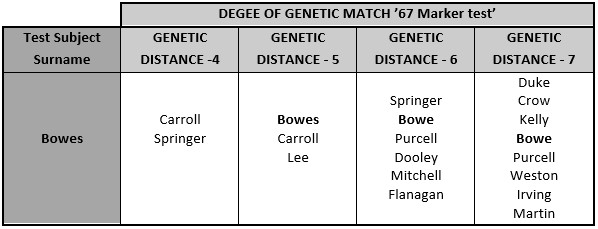
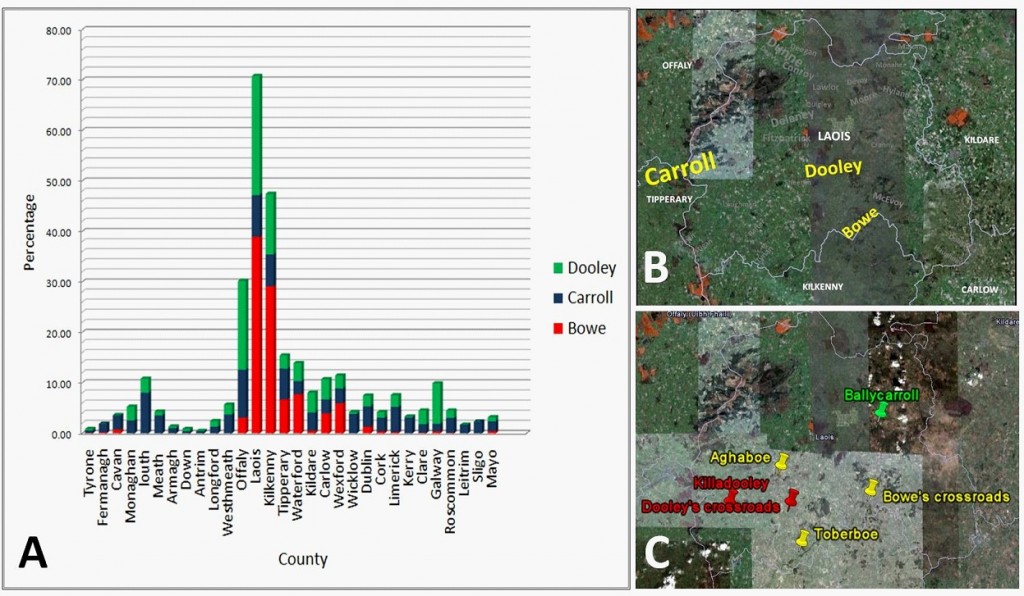
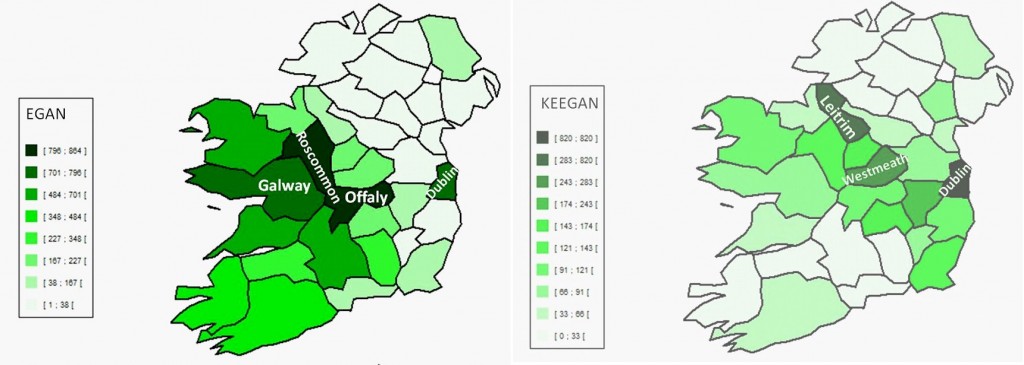
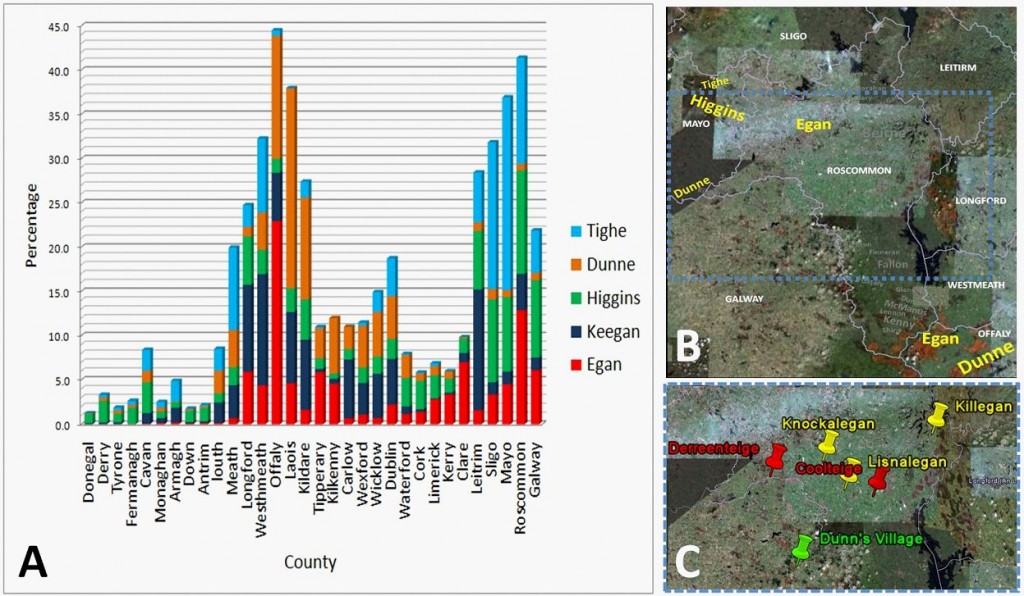

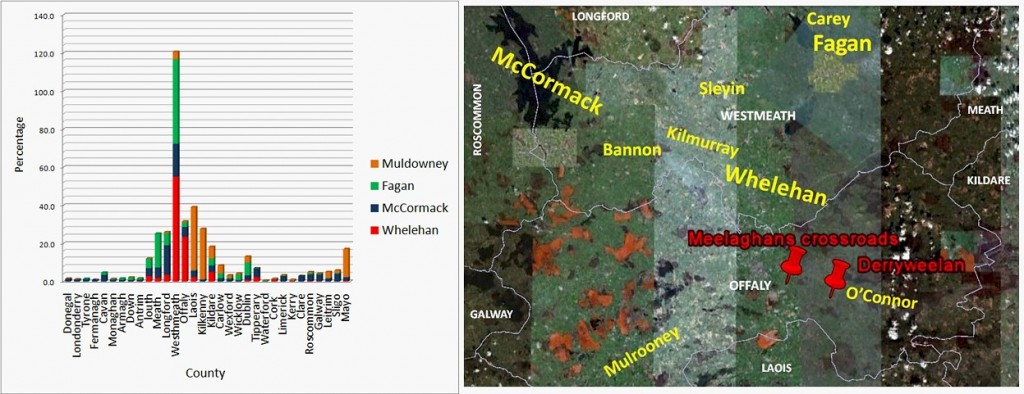
Brad Larkin
Spelling of “Ordnance Survey” corrected.